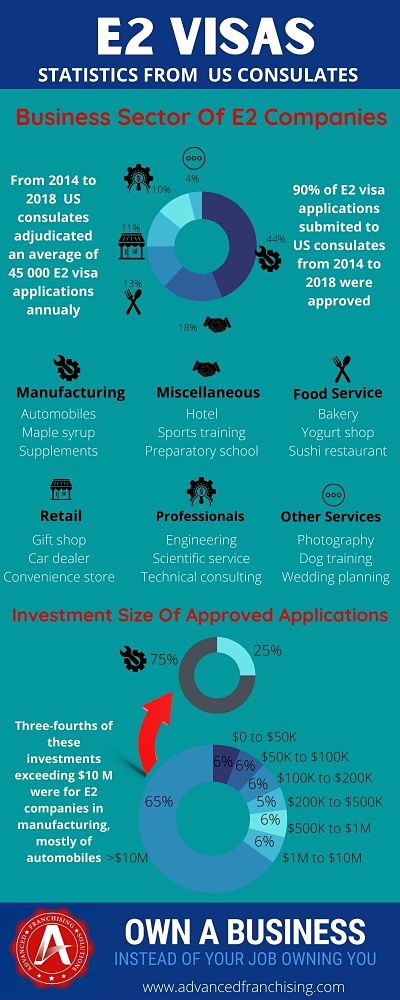Many people dream of one day becoming their own boss, and maybe you have a dream of opening a business in the United States. If you plan to do this, applying for an E2 visa can be a great way to get entrance into the country to start living your American dream. But what do you do if that dream falls flat and your business fails?
Business failures are an unfortunate risk of entrepreneurship, and E2 businesses come with a special set of risks. Read on to learn more about these risks and how you can improve your chances of launching a successful E2 business.
What Are E2 Businesses?
Before we dive into the success and failure rates of E2 businesses, let’s talk some about what they are. An E2 visa is designed to help investors move to the United States to start a new business here. This is a temporary visa and comes with a variety of strict requirements, which we’ll discuss more in a moment.
Unlike some other business visas, an E2 visa requires investors to put up a significant initial investment. This is a form of “good faith” money designed to ensure that the investor will do what it takes to make sure their business is successful. And because the visa is temporary, your business will need to succeed if you plan to renew your visa.

Basic Qualifications for an E2 Visa
To qualify for an E2 visa, there are a few basic standards you’ll need to meet. First of all, you must come from a country that has a treaty of commerce and navigation with the United States. You can find a list of these countries on the U.S. Department of State’s website, along with details about what sort of treaty they maintain.
Second, you must have invested or be in the process of investing a “substantial amount of capital” in a business based in the United States. We’ll delve more into what this means and why it can put E2 businesses at higher risk in a moment. Finally, E2 investors must be coming to the United States for the sole purpose of starting their business.
Significant Initial Investment
The E2 application requirements state that you must invest a substantial amount of capital for your visa application to be approved. However, no set dollar amount qualifies as “substantial capital.” Instead, this depends on the scale and scope of your business and what it will take for it to succeed.
In effect, the government wants to see that you’re willing to put up the investment it will take to give your business a strong start. If you’re planning on starting a larger business, your initial investment amount will need to be more. But if you’re planning on starting a business that doesn’t require much special equipment or even a building, you can get away with a smaller investment upfront.
The “At-Risk” Factor
If you dive deeper into the E2 visa requirements, you’ll discover that part of this “substantial amount of capital” requirement is the “at-risk” factor. The government wants to see that you’re invested in making sure your business venture here is a success. This means you must be willing to put a significant amount of your money at risk if the business fails.
The “at-risk” factor requires that you have a significant portion of that upfront investment committed to launching your business. You must have bought some equipment, taken out a lease on a business location, or bought other goods dedicated to the business. While this requirement does help ensure E2 applicants are serious about their businesses, it can also put them in a worse financial spot if the business fails.
Keeping Your Business Non-Marginal
There’s another requirement for an E2 visa that states your business can’t be considered marginal. This means that your business has to employ more than just you; it must provide jobs for other workers in the United States. If your business won’t have other employees at first, you’ll need to provide a personnel forecast showing exactly when you’ll need workers and what they’ll be doing.
This rule is meant to ensure that businesses started on an E2 visa are contributing positively to their communities. However, it also makes the requirements for success that much steeper for entrepreneurs. Not only does your business have to make enough money to keep you afloat, but you also have to be able to pay your staff and handle issues like taxes and insurance.

How Many E2 Visa Applications Are Approved?
Before you apply for an E2 visa, it’s a good idea to know how likely you are to get that approval. After all, considering you have to invest a large sum of money before you apply, you don’t want to go in knowing there’s a 50 percent shot you’ll fail. The good news is that, in most cases, the United States wants to welcome business owners striving to improve their futures and their new communities.
About 80 percent of E2 applications get approved, meaning there’s a very good chance that your business plan will make the cut. Ensuring that you’ve gone through all the steps and invested the money you need to before you apply will also help to improve your chances of success. However, keep in mind that one in five of these applications is still rejected, so be sure you prepare for the worst, too.
How Many Businesses Fail?
So now that we know a little more about the particular risks E2 business owners face, let’s look at overall business success rates. Running a small business is hard and requires a lot of initial investment on the business owner’s part. Whether or not you’re dealing with the additional risks of an E2 business, there’s a good chance you could get in over your head.
According to the Bureau of Labor Statistics, about 20 percent of small businesses fail within their first year, and 30 percent fail within the first two years. Half of all small businesses shut down within their first five years of operation. And within the first decade of operation, a whopping 70 percent of all small businesses will close their doors for good.
Do Your Homework
Those numbers can be terrifying, especially if you’re staking your family’s future on the success of your business. However, there are some things you can do to improve your chances of making it into that final 30 percent. First and foremost, you need to research, research, research before you launch your business plan.
You need to know everything you possibly can about the market you’re planning to open a business in. You need to know about any potential competitors you’ll have and whether the market in that area is already saturated with a certain type of business. You should also know how that industry has changed in that area in the last few years and what customers look for in businesses in that sector.

Create a Strong Business Plan
Once you’ve done your homework, you’ll need to start creating a strong business plan for yourself. Your business plan will be your guide as you decide how much funding you need, how you’ll get the revenue you need, and when and how you’ll expand your business. You’ll be able to determine when you need to do more research and what success will mean for you.
You’ll need to begin your business plan with achievable goals for your business. You may want to use the SMART model when you’re writing these goals. Once you have your goals in place, you can start writing out the specifics of how you’ll achieve those goals, including contingency plans if things don’t go as expected.
Get Solid Financing
One of the major problems many small businesses run into is a lack of funding. Business expenses outstrip the business owner’s expectations, revenues aren’t as high as they might have hoped, and the entrepreneur finds themselves unable to make ends meet. The best way to counter this pitfall is to make sure you have a solid financing plan from the word “go.”
First of all, always be as realistic as possible about how much money you’ll need to run your business and make it profitable. Even if that number is scary, it’s much better to plan for that number ahead of time than to find out halfway into your first year that you needed more money than you thought. And always build in a little padding when saving up to start your business or getting a business loan so you can handle the unexpected challenges that turn up.
Find a Good Location
When it comes to business real estate, the golden rule is the three L’s: location, location, location. You need to make sure your business is located somewhere where you’ll get plenty of visibility and traffic. This is especially important if you’re a public-facing business or one that relies on spontaneous foot traffic.
Make sure you get a location in as reputable a part of town as possible, preferably in a popular shopping area. Try to position yourself in an area with a lot of pedestrian traffic that provides easy access to parking. And do your best to make your business atmosphere beautiful and clean so your customers have a good experience when they come in.

Build Your Internet Presence
These days, having a strong internet presence is just as important, if not more so, than having a good physical location. Your website will give potential customers a chance to learn some about your business and can bring in new customers. It will also give customers important information about your business, including hours, product offerings, location, contact information, and more.
Make sure you build a beautiful, functional website that is easy for customers to navigate. You also need to set up profiles on all the major social media platforms, including Facebook, Twitter, and Instagram. Use these to market your business, link back to your website, and keep customers up to date on your latest offerings.
Invest in Branding
While having a strong online presence is incredibly important, you need to make sure that that presence represents your company well. Clashing colors, sloppy graphic design, and an unprofessional logo (or no logo at all) will diminish your company’s reputation. It’s a good idea to allocate a portion of your up-front investment for good branding.
Work with a graphic designer to create a stylish logo that represents both the function and the atmosphere of your new business. Use the colors and fonts in that logo across your website, any merchandise you may get for your company, and even in your business decorating. Not only will this branding make your company seem more reputable, but it will also help customers to identify your business when they see it.

Adapt Your Plan
Once you get a solid business plan worked out, it can be easy to get stuck on the details of that plan. You may feel like you just have to stick to your plan, even when things aren’t going well, and eventually, you’ll find success. But when certain aspects of your plan aren’t working, you have to be able to adapt and work out new strategies.
Always keep an eye on your business performance indicators, and strive to improve areas that aren’t working for you. Keep your efforts based on data you gather from your company, rather than working off of what you feel will and won’t work. Don’t be afraid to scrap sections of your plan that aren’t working and try a different approach that will be more effective.
Learn to Prevent Business Failures
Starting any business is a risky venture, and starting an E2 business can be even more so. While the rate of failure among small businesses is dauntingly high, there are things you can do to mitigate that risk. Always do your research, plan for the worst, focus on marketing, and don’t be afraid to adapt your plan as needed.
If you’d like to discover more ways to reduce your risk of business failures, check out the rest of our site at Advanced Franchising Solutions. Our proven process will save you time, help you avoid frustration, and streamline your franchise opportunity search. Get a free franchise education today and take the first step to owning a business instead of your job owning you.
